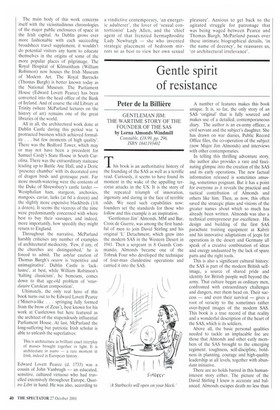The bad luck of the Irish
Peter J. M. Wayne
PUBLIC ARCHITECTURE IN IRELAND, 1680-1760 by Edward McParland
Yale, .1.35, pp. 241, ISBN 0300090641
he nearest Sir Christopher Wren came to building anything in Ireland was the prefabricated 'itinerant house' he designed for William III during the campaigns of the 1690s. Neither Vanbrugh, Hawksmoor, Archer, Gibbs nor Burlington are known to have worked there either, At the end of the 17th century, Ireland was a vice-regality known only for 'its inertia, inefficiency, muddle [and] corruption'.
In a less capable pair of hands (and the less than inspiring title of this volume barely helps tempt the wavering reader in), such an unpromising tnise-en-sc ene could so easily have led to a dismal trudge through what many might consider to be 80 years in the provincial backwaters of architectural history. William Robinson? Thomas Burgh? Arthur Dobbs? Arthur Jones Nevill? Here we are presented with a cast of little known architects of the second division; an array of obscure military engineers and draughtsmen; an unresolvable plot about the wranglings of bigoted clerics and selfaggrandising politicians as they squabble over the unfathomable complexities of draining bogs and digging ditches, financing forts and fortifications, and fitting out charter schools so they might best produce 'obedient and peaceable subjects to the king'.
Fortunately, Edward McParland's are not just any old pair of hands. He handles his brief throughout with elan and impressive erudition:
The oculi in the diagonals of the drum mediate between the rectangular arid of the massing below and the resolution in the fluted (and seemingly unbuttressed) dome above,
he explains, without batting an eyelid, of Richard Castle's startlingly beautiful Market House in Dunlavin, Co. Wicklow. Well, yes. There are admittedly times when he soars off into stratospheric flights of esoteric description which may leave the less architecturally initiated floundering in the middle distance. A certain amount of concentration and perseverance are sometimes necessary to get the most from this book. Such efforts are in the end rewarded by moments of true aesthetic enlightenment. The main body of this work concerns itself with the vicissitudinous chronologies of the major public enclosures of space in the Irish capital. As Dublin grows ever more fashionable with each succeeding broadsheet travel supplement, it wouldn't do potential visitors any harm to educate themselves in the origins of some of the more popular places of pilgrimage. The Royal Hospital of Kilmainham (William Robinson) now houses the Irish Museum of Modern Art. The Royal Barracks (Thomas Burgh) is better known today as the National Museum. The Parliament House (Edward Lovett Pearce) has been converted into the head office of the Bank of Ireland. And of course the old Library at Trinity (where McParland lectures on the history of art) remains one of the great libraries of the world.
All in all, the architectural work done at Dublin Castle during this period was 'a protracted business which achieved formality . . . but few moments of high quality'. There was the Bedford Tower, which may or may not have been a precedent for Samuel Cardy's State House in South Carolina. There was the extraordinary staircase leading up to Battle Axe Hall, and a Doric 'presence chamber' with its decorated cove of dragon birds and grotesque putti. Far more mouth-watering were the contents of the Duke of Shrewsbury's castle larder — Westphalian ham, sturgeon, anchovies, mangoes, caviar. larks (at 6d a dozen) and the slightly more expensive blackbirds (1/6 a dozen). It seems the viceroys of the time were predominantly concerned with where best to buy their sausages, and indeed, more importantly, how speedily they might return to England.
Throughout the narrative, McParland harshly criticises any number of examples of architectural mediocrity. 'Few, if any, of the churches are distinguished,' he is forced to admit. The astylar caution of Thomas Burgh's oeuvre is 'repetitive and unimaginative'. Dublin Castle is 'lacklustre', at best, while William Robinson's 'halting classicism', he bemoans, comes down to that age-old problem of `retardataire Carolean composition'.
Ultimately, the only real hero of this book turns out to be Edward Lovett Pearce (Minerva-like . . . springing fully formed from the brow of Zeus'), best known for his work at Castletown but here featured as the architect of the stupendously influential Parliament House. At last, McParland the long-suffering but patriotic Irish scholar is able to unleash the superlatives:
This is architecture as brilliant exact interplay of masses brought together in light. It is architecture in teatro — a rare moment in Irish. indeed in European history.
Edward Lovett Pearce (d. 1733) was a cousin of John Vanbrugh — an educated, sensitive, cultured virtuoso who had travelled extensively throughout Europe, Quattro Libri in hand. He was also, according to
a vindictive contemporary, 'an energetic adulterer', the lover of 'sexual contortionist' Lady Allen, and the 'chief agent of that frenzied hermaphrodite Lady Newburgh — she who invented strategic placement of bedroom mirrors so as best to view her own sexual
pleasure'. Anxious to get back to the agitated struggle for patronage that was being waged between Pearce and Thomas Burgh, McParland passes over these intimate biographical details, In the name of decency', he reassures us, 'or architectural irrelevance'.











































































 Previous page
Previous page